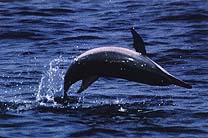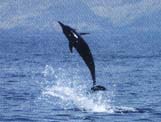Text and pictures by Robert Baldwin
Flat, glistening, tranquil. Not the desert of Arabia, but the Gulf of Oman, rich in nutrients, a bounty of natural resources. Among them, the Sultanate's cetaceans, a well-kept secret of scientific, cultural and aesthetic appeal. Robert Baldwin is an accomplished diver and marine biologist who has co-authored a guide to skin-diving in Oman. He has taken a particular interest in Arabia's rich cetacean fauna, of which the spinner dolphin is one of the most spectacular, at least in terms of their antics.
 There is a relative lack of knowledge of whales and dolphins found around the Arabian peninsula, a myriad of unanswered questions surrounding each of the 15 species so far identified. And yet, if revealed, the few facts known would surely generate a tidal wave of interest and attention. The story of the spinner dolphin (Stenella longirostris), an agile acrobat, abundant and commonly seen in the calm waters of the Gulf of Oman, hints at the substance of Arabia's cetacean secret.
There is a relative lack of knowledge of whales and dolphins found around the Arabian peninsula, a myriad of unanswered questions surrounding each of the 15 species so far identified. And yet, if revealed, the few facts known would surely generate a tidal wave of interest and attention. The story of the spinner dolphin (Stenella longirostris), an agile acrobat, abundant and commonly seen in the calm waters of the Gulf of Oman, hints at the substance of Arabia's cetacean secret.
THE NATURAL ARENA
The spinner dolphin is justly named for its spectacular spinning behaviour, unique to, and diagnostic of, the species. Leaping three metres or more into the air and spinning like a barrel, before slapping back down into the water may be a form of communication or an attempt to dislodge irritating parasites. Or perhaps it is just a playful spirit that drives the behaviour. Three or four kilometres off the rocky coast of Muscat, spinner dolphins often put on dazzling displays of grace, agility and speed, including double backward flips, somersaults, leaps and spins, to contest any aquarium show.
Groups of up to 1,000 spinner dolphins have been observed along the Gulf of Oman coast, and smaller groups of three or four hundred are regularly encountered. Only a handful of private boat owners venture out to watch, as streamlined shapes dart to the bow-waves of their boats, sometimes remaining with a chosen craft for several hours.
Underwater, patient snorkellers are ap-proached with caution and curiosity, and regaled with the staccato music of resonant clicks, pulses, squeaks and whistles that forms their characteristic call-sign. Before long, normal behaviour resumes, with much nudging and caressing, and frequent coupling. Very young dolphins swim shielded by an ever-present mother or "baby-sitter" whom they will stay alongside for two or more years before they venture out to make their own way in the school.
 MIXED RELATIVES AND FISHY FRIENDS
MIXED RELATIVES AND FISHY FRIENDS
It is not uncommon to find spinner dolphins in mixed schools with the more robust common dolphin (Delphis delphis), the latter usually towards the outside of the group. Such schools are often observed feeding in relatively deep water, several kilometres offshore. In one instance a school of sardines surrounded divers, forming a tight, writhing ball of fish. They were apparently using the two divers as cover since they watched in awe as spinner dolphins carved through the fish, taking mouthfuls as they swam. It seemed as if the dolphins had organised themselves into a co-ordinated hunting group. Feeding packs of three or four individuals powered their way through the ball of sardines in sequential droves before circling to join the other members of the school, herding the fish together, and waiting for their turn to feed.
Seen for the first time in Oman's waters in May 1993, pan tropical spotted dolphins (Stenella attenuata) are now also known to school with spinner and common dolphins, making a threesome of related species, about which little is known. It is possible that mixed schools of this type are more common further offshore. However, it is the spinner dolphins association with another kind of animal that has earned it a place in Oman's rich culture.
Local, traditional fishermen respect and revere "hout", "the dolphin that spins". Some even talk of the dolphins as if they were deceased relatives. Without them, locating and keeping track of tuna, a fish fetching one of the highest prices at the local 'suq', would be virtually impossible. Standing at the bows of their boats, fishermen can scan the horizon for a tell-tale splash or the arch of a glinting back in the dawn light. Then, racing ahead of a dolphin school, fishermen sink their baited hooks, wrapped around and weighted by a stone attached by means of a slip-knot. Long ago, trial and error taught them that the tuna are to be found feeding below the dolphins. The bait falls through the water, glistening and glinting enticingly as the line unravels, until, with a sharp tug, the stone is released, leaving the baited hook free. Tuna invariably succumb to the fisherman's tactic, which the dolphins seem able to foresee. However, nets, once traditionally woven, now bought with government subsidy, are also set to catch tuna. It is a sad and well rehearsed irony that the "hout", which by its high spins and graceful leaps signals to the fishermen the presence of their livelihood, also, all too often, becomes entangled in the monofilament, virtually invisible, netting. The death of spinner dolphins, and indeed of all cetaceans, largely passes unnoticed, except perhaps for the fisherman's family, who may decide to utilise the carcasses as fertiliser for their date palms.
SANCTUARY TO A NEW SPECIES
As Arabia's only member of the International Whaling Committee, the Sultanate of Oman has played an evocative role in the plight of cetaceans world-wide, particularly in connection with the Indian Ocean Whale Sanctuary. Nevertheless, to date, no specific legal protection has been granted for any of the cetaceans of Oman, despite the continued death-toll. The importance of conservation of the spinner dolphin, and indeed of all cetaceans in Oman, became all the more acute when, during the course of a seven year coastal zone management project conducted by IUCN, small groups of dolphins of uncertain identity were sighted. Very similar in appearance to the spinner dolphin, the small, stocky, pink-bellied dolphins that are still occasionally seen, were at first assumed to be juvenile spinner dolphins. On closer inspection, the dolphins seemed to have more striking facial markings with shorter, dark tipped snouts and to have somewhat different behaviour. Until such time as a detailed taxonomic study is carried out, the true identity of the dolphins must remain an enigma, but could well be a race or species new to science.
A SPINNING WHEEL OF TALES
The story of the spectacular spinner dolphin in the Gulf of Oman is just one of many to be told about Oman's cetaceans; from humpback whales (Megaptera novaeangliae) which may be the world's only non-migrating population of this species; to the humpback dolphin (Sousa chinensis), whose populations are curiously split by a stretch of over 500 kilometres of coastline where they have not been recorded. And yet, without sufficient legal protection, all of Arabia's cetaceans are at risk. There is still time to ensure their survival. It is a task well worth the effort.
Arabian Wildlife. Volume 1, Number 1